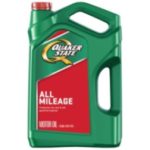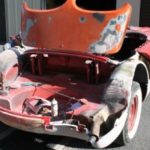Mercury: Tips on Improving Your Boat’s Fuel Efficiency
Boat Early, Boat Often
It’s no secret that we’re all getting hit a lot harder at the gas pump these days, and it may be some time before we see any real relief. Some might be tempted to boat or fish less to save some cash, and that’s understandable. But doing so just means you’re not using an asset – one that brings you and your family a great deal of enjoyment, most likely – that you’ve paid good money to acquire, store and insure. A better option is to optimize your boat’s fuel economy and your operating technique so you can hit the water without getting stung by a high fuel bill.
The following list will give you some ways to save on fuel. Every item won’t apply to every boat, and none of them alone will magically give your boat the fuel economy of a kayak. But if you apply as much of this as you can to your vessel, you’re virtually guaranteed to burn less fuel than you would have otherwise.
1. Make Sure You’re Properly Propped
If your boat isn’t propped correctly, it’s almost certainly not as efficient as it should be. To see if your boat has the right propeller, take a few minutes to work through the Mercury Prop Selector and compare its suggestions with the propeller you’re currently using. If your current prop doesn’t closely match one of the suggestions, there’s a good chance you need to consider a different one.
There are many design factors that determine how a prop performs and its overall efficiency for a given boat and application. For instance, you might need to change pitch, diameter or number of blades within your current prop family, or you might be better off choosing an entirely different model. For expert help in verifying if your propeller is right for your boat, or to select a new one, contact your local Mercury Authorized Dealer.
Even if you’ve already got the perfect propeller, you still need to give it a thorough inspection to ensure that it’s in good condition. A couple of tiny nicks probably won’t affect your fuel economy much, but if you’ve got any cracks, bent blades or significant dings, it’s almost certainly time for a new one.
2. Monitor Fuel Flow and Efficiency
Many people aren’t aware of the fact that fuel efficiency on any boat drops dramatically at the upper reaches of the rpm range. But if you’re watching the information provided by Mercury SmartCraft gauges, a VesselView display or a connected compatible display from another leading brand, you can see exactly where in the throttle range your miles per gallon rate starts to degrade, which allows you to make an informed decision regarding the tradeoff between efficiency and speed.
SmartCraft data shows you real-time mpg and gph, so you can see where your boat’s best cruise is observe how adjusting throttle and trim affects your fuel consumption.
3. Trim Your Engine Properly
Proper engine trimming – adjusting your gearcase or drive in and out in accordance with your speed and the conditions – is one of the hardest things for novice boaters to master, but it’s also one of the most important in your quest for optimum fuel efficiency. So if you’re not quite sure if you’re trimming correctly, read up about it and then get a more experienced boater to ride with you to help you understand what to do and when. Finding the right amount of trim at all speeds and sea conditions can improve your fuel economy quite a bit, and it will also noticeably improve your top speed and overall ride.
To get perfect trim virtually 100 percent of the time, you can add the Mercury Active Trim feature to your SmartCraft-enabled vessel. Active Trim is a speed-based automatic engine trim system that continually adjusts the engine trim in or out as you change speeds with no driver action or trimming expertise needed. Active Trim makes operating a boat so much easier that it has been likened to moving from a manual transmission vehicle to one with automatic transmission. The trimming profile is vessel-specific, and it is set up by the boatbuilder or installing dealer so there’s no user programming or setup needed. It can also be manually overridden as required for rough seas and other special situations. The system even allows the boat operator to adjust profile options so you can further personalize trim characteristics for different driving styles and boat load conditions.
The remarkable thing about Active Trim is that it has been proven to improve fuel economy versus manually trimming a boat, delivering valuable savings with the touch of a button. Active Trim isn’t, however, just an aid for beginning boaters: Charter captains and others with thousands of hours of experience are using it every day by default.
4. Reduce Weight
Boats tend to gain a lot of weight throughout the boating season in the form of the equipment and toys that get stowed and forgotten. Those unnecessary pounds can add up to a not-inconsequential reduction in fuel economy. If you haven’t done so in a while and have a couple of hours to kill, take every item out of your boat and set it in your yard. Then only put an item back aboard if it meets two criteria: 1. It must be in good working order, and 2. It must be something that you would honestly go buy and put on the boat if you didn’t already have it. If an item doesn’t meet both of those conditions, it needs to go into storage for circumstances when it’s needed, or you should consider selling or giving it away.
Start Saving Now
Each one of the above fuel-saving tactics will help you use less fuel. When you add them all together, the combined results may really surprise you. While some of them will require a modest investment – installing Active Trim or buying a new propeller, for instance – every dollar you spend to improve fuel economy will pay dividends for years to come. More importantly, improving your fuel economy will allow you to spend more time on the water and less time worrying about what the numbers on the gas pump are going to say at the end of the day.
COMPANY DETAILS |

|
|
Company |
Mercury Marine |
|
Website |
|
|
Connect |
   
|
|
Contact |
ABOUT Mercury Marine®
Mercury Marine has been making world-class outboards and sterndrives for more than 75 years. They started back in 1939 in a small machine shop in Wisconsin, and they’ve grown into the largest builder of marine propulsion systems in the world. Number one on the water. And we didn’t get there by sitting still.





